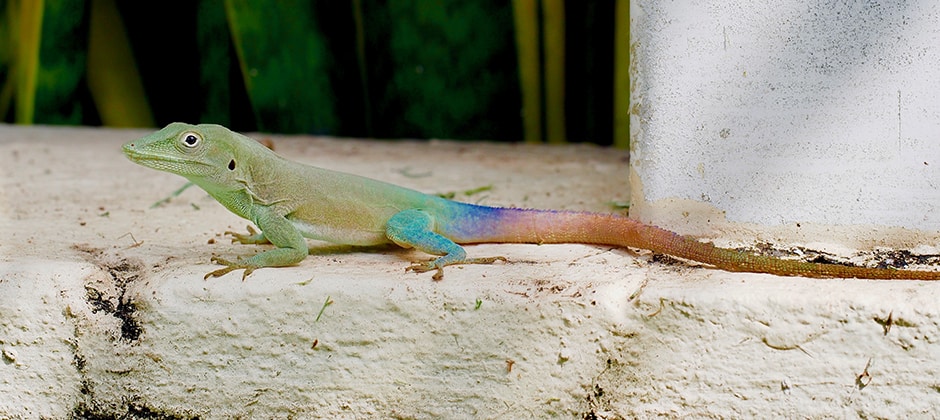Share this article
Q&A: Kristin Winchell on why urban ecology matters
Cities are growing in some parts of the world at an extraordinary rate, swallowing up swaths of formerly wild habitat. But as these urban environments become the norm in some areas, some wildlife continues to find niche habitats they can exploit even in the densest human areas.
While many biologists have traditionally focused on the wilder parts of the globe, a growing body of research is turning to species thriving in cities.
Kristin Winchell, a postdoctoral research associate in evolutionary biology at Washington University in St. Louis, first tuned into this community of researchers while studying urban anole lizards.

Kristin Winchell is one of the three authors of the “Life in the City” blog about urban ecology and evolution research. Courtesy of Kristin Winchell
She and two of her colleagues, Elizabeth Carlen, a PhD candidate at Fordham University, and Lindsay Miles, a postdoctoral fellow at the University of Toronto Mississauga, came together just over a year ago to create a blog called “Life in the City: Evolution in an Urbanizing World,” where wildlife researchers could stay up to date with new research and exchange ideas about the topic. We caught up with Winchell to discuss her blog and why it’s important for biologists to focus on urban ecology and evolution. The interview is edited for brevity and style.
Why is it so important to learn more about the ways creatures are evolving to live in urban areas?
Just knowing about the wildlife that’s around us on a day-to-day basis and making that connection is really important. They’re in the cities living with us. Who hasn’t observed an animal outside their houses or as they’re walking down the street and wondered something about that animal?
There are also conservation reasons for studying animals in urban areas. Urbanization is intensifying and expanding, so we really need to understand not only which species are persisting in urban areas, but how they are doing that and what aspects in the environment are necessary to ensure that happens.
Is there anything that blew your mind in urban ecology?
I worked on urban turtles for my master’s. That was the first time my mind was blown by urban wildlife. I think that like most people who don’t work in this subject area, I went into my master’s thinking that turtles in urban areas were going to be the worst. I thought there were going to be poor populations that would have skewed sex ratios, and it would all be terrible. But I remember just being shocked about how abundant the wildlife was and how healthy the populations and individuals were when I actually sat down and sampled them.
That’s the biggest ‘A-ha!’ moment that I had.
How do our definitions of artificial versus natural, or wild versus tame, affect the way we study biology?
This is a big point that people in our field need to get over. Historically, people have thought that urban areas are outside the natural realm — that urban areas are artificial. I don’t like referring to urban areas as artificial, because it implies that they are somehow outside the natural world. Urban habitats are exactly that: they’re habitats. They exist in the same natural world as forests and other natural ecosystems. They’re subject to the same ecological and evolutionary rules.
These definitions we have of artificial and natural pigeonhole urban species and human spaces as something not worth studying. That does a disservice to the animals here as well as to our process in understanding and answering basic evolutionary questions.
Can understanding more about the evolution of urban wildlife help us to conserve other endangered or threatened species?
We need to recognize that we don’t know which species are going to be threatened by urbanization in the future. Urbanization is an ongoing, intensifying process. Many species have never encountered urbanization. We also can’t assume that a species thriving in an urban settlement will continue to thrive there. Even the most robust urban species are going to have a tipping point when that environment no longer supports its survival. So it’s important not to focus just on the endangered and threatened species, but also remember that we are entering unknown territory as we intensify these cities, and we can’t take for granted that common species will continue to remain common.
Also, we don’t know how many of these species that haven’t encountered urbanization yet are going to respond. There may be key traits in different species’ evolutionary histories that determine how they will respond to urbanization. By studying these patterns of opportunity and resilience in urban areas, we can get an idea about which species we need to focus our conservation efforts on.
The main focus of this type of research should be how do we stop more species from becoming endangered and threatened as urbanization continues to intensify.
Header Image: Graham’s anole (Anolis grahami) is a species that has managed to thrive in urban areas in Jamaica and where it has been introduced in Bermuda. ©Kristin Winchell








